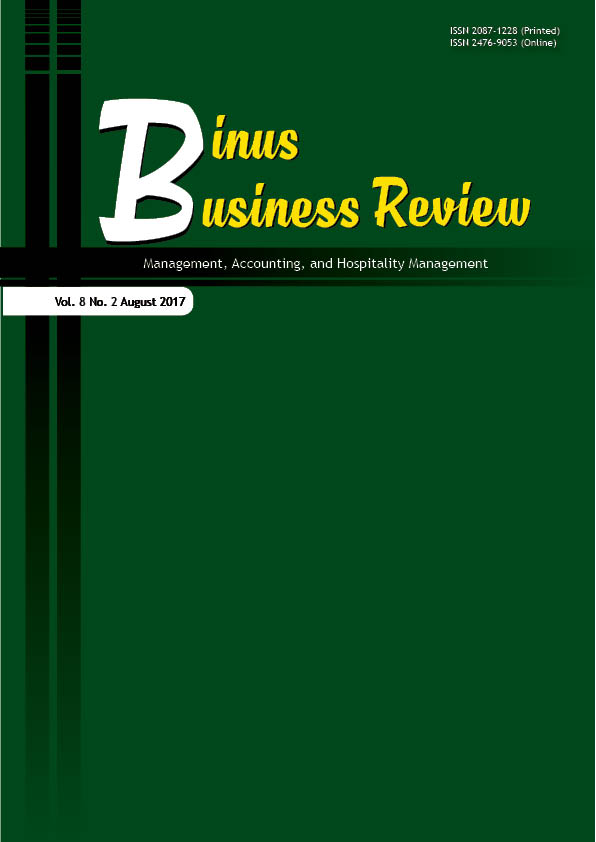Firm Size as Moderator to Non-Linear Leverage-Performance Relation: An Emerging Market Review
DOI:
https://doi.org/10.21512/bbr.v8i2.1711Keywords:
leverage, performance, capital structure, moderation, firm sizeAbstract
The purpose of this research was to investigate leverage-performance relation with moderating firm size in developing countries like Pakistan. Data were collected from 304 Pakistani non-financial firms for the period of 2005-2013. It is found that overall leverage-performance relation is negative for all types of firms. However,
such losses are more prominent for small size firms. Results also show that the leverage-performance relation is nonlinear for medium and large size firms. However, these firms are not targeting optimal level and overleveraging that ultimately decrease their profits. So, financial managers of small size firms should avoid debt financing while for large and medium size firms, managers need to adjust their debt ratio to its optimal level.
References
Abor, J. (2010). Debt policy and performance of SMEs Evidence from Ghanaian and South African. The Journal of Risk Finance, 8(4), 364–379. doi:10.1108/15265940710777315
Ezeoha, A. E. (2008). Firm size and corporate financial-leverage choice in a developing economy: Evidence from Nigeria. The Journal of Risk Finance, 9(4), 351–364. doi:10.1108/15265940810895016
Fama, E., & French, K. (1998). Taxes, financing decisions, and firm value. Journal of Finance, 53(2), 819–843.
Gama, A. P. M., & Galvão, J. M. M. (2012). Performance , valuation and capital structure : survey of family firms. Corporate Governance, 12(2), 199–214. doi:10.1108/14720701211214089
González, V. M., & González, F. (2012). Firm size and capital structure: Evidence using dynamic panel data. Applied Economics, 44(36), 4745–4754. doi:10.1080/00036846.2011.595690
Graham, J. R. (2000). How big are the tax benefits of debt? Journal of Finance, 55(5), 1901–1941.
Harris, M., & Raviv, A. (1991). The Theory of Capital Structure. The Journal of Finance, 46(1), 297–355.
Jaggi, B., & Gul, F. A. (1999). An Analysis of Joint Effects of Investment Opportunity Set , Free Cash Flows and Size on Corporate Debt Policy. Review of Quantitative Finance and Accounting, 12(4), 371–381.
Jensen, M. (1986). Agency Costs of Free Cash Flow, Corporate Finance and Takeovers. American Economic Review, 76(2), 323–329.
Jensen, M., & Meckling, W. (1976). Theory of the firm, managerial behavior, agency costs and ownership structure. Journal of Financial Economics, 3(1), 30–60.
Jermias, J. (2008). The relative influence of competitive intensity and business strategy on the relationship between financial leverage and performance. The British Accounting Review, 40, 71–86. doi:10.1016/j.bar.2007.11.001
Kim, W. S., & Sorensen. (1986). Evidence on the impact of the agency costs of debt on corporate debt policy. Journal of Financial and Quantitative Analysis, 21(2), 131–144.
Lemmon, & Zender. (2001). Looking under the lamppost: An empirical examination of the determinants of capital structure (No. 2192502). Retrieved from http://leeds-faculty.colorado.edu/Zender/papers/LZjun_07_01.pdf
McConnell, J., & Servaes, H. (1995). Equity Ownership and the Two Faces of Debt. Journal of Financial Economics, 39(1), 131–157.
Modigliani, F., & Miller, M. (1958). The cost of capital, corporate finance and the theory of investment. American Economic Review, 48(1), 261–297.
Myers, & Majluf, N. (1984). Corporate financing and investment decisions when firms have information that investors do not have. Journal of Financial Economics, 13(1), 187–221.
Myers, S. C. (1984). The Capital Structure Puzzle. The Journal of Finance, 39(3), 575–592. doi:10.2307/2327916
O’Brien, J. (2003). The capital structure implication of pursuing a strategy of innovation. Strategic Management Journal, 24(2), 415–431.
Ozenbas, D., & Portes, L.-S.-V. (2011). Does Firm Size Matter? The Relationship between Firm Level Volatility, GDP Volatility and Capital Structure Decisions for Firms of Different Size Groups. The Business Review, 17(2), 35–41.
Raza, H., Aslam, S., & Farooq, U. (2013). Financing Pattern in Developing Nations Empirical Evidence from Pakistan. World Applied Sciences Journal, 22(9), 1279–1285. doi:10.5829/idosi.wasj.2013.22.09.40
Shihua, W., & Jianhua, L. (2010). Notice of Retraction Firm Size and Capital Structure Choice. International Conference on E-Business and E-Government, 4051–4056. doi:10.1109/ICEE.2010.1017
Simerly, R., & Li, M. (2000). Environmental dynamism, financial leverage and performance: a theoretical integration and an empirical test. Strategic Management Journal, 21(1), 31–49.
Stretcher, R., & Johnson, S. (2011). Capital structure: professional management guidance. Managerial Finance, 37(8), 788–804. doi:10.1108/03074351111146229
Torres-Reyna, O. (2007). Panel data analysis fixed and random effects using Stata (v. 4.2). Retrieved from http://www.demonish.com/cracker/1426308968_fc8b5f133d/panel101.pdf
Voulgaris, F., Asteriou, D., & Agiomirgianakis, G. (2004). Size and Determinants of Capital Structure in the Greek Manufacturing Sector. International Review of Applied Economics, 18(2), 247–262. doi:10.1080/0269217042000186714
Zeitun, R., & Tian, G. G. (2007). Capital structure and corporate performance : evidence from Jordan. Australasian Accounting Business and Finance Journal, 1(4), 40–61.
Downloads
Published
How to Cite
Issue
Section
License
Authors who publish with this journal agree to the following terms:
a. Authors retain copyright and grant the journal right of first publication with the work simultaneously licensed under a Creative Commons Attribution License - Share Alike that allows others to share the work with an acknowledgment of the work's authorship and initial publication in this journal.
b. Authors are able to enter into separate, additional contractual arrangements for the non-exclusive distribution of the journal's published version of the work (e.g., post it to an institutional repository or publish it in a book), with an acknowledgment of its initial publication in this journal.
c. Authors are permitted and encouraged to post their work online (e.g., in institutional repositories or on their website) prior to and during the submission process, as it can lead to productive exchanges, as well as earlier and greater citation of published work.
USER RIGHTS
All articles published Open Access will be immediately and permanently free for everyone to read and download. We are continuously working with our author communities to select the best choice of license options, currently being defined for this journal as follows: Creative Commons Attribution-Share Alike (CC BY-SA)





















